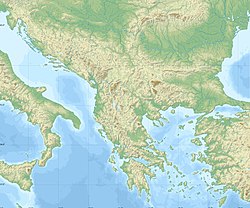Athens
Athens
Αθήνα | |
|---|---|
Capital city | |
| Nicknames: τὸ κλεινὸν ἄστυ(tò kleinòn ásty,"the glorious city" ) τὸ ἰοστεφὲς ἄστυ(tò iostephès ásty,"theviolet-crowned city") The City of Wisdom[1] City of Reason[2] | |
| Coordinates:37°59′03″N23°43′41″E/ 37.98417°N 23.72806°E | |
| Country | Greece |
| Geographic region | Central Greece |
| Administrative region | Attica |
| Regional unit | Central Athens |
| Named for | Athena |
| Districts | 7 |
| Government | |
| • Type | Mayor–council government |
| •Mayor | Haris Doukas[3](PASOK) |
| Area | |
| • Capital city and municipality | 38.964 km2(15.044 sq mi) |
| • Urban | 412 km2(159 sq mi) |
| • Metro | 2,928.717 km2(1,130.784 sq mi) |
| Highest elevation | 338 m (1,109 ft) |
| Lowest elevation | 70.1 m (230.0 ft) |
| Population (2021)[4] | |
| • Capital city and municipality | 643,452 |
| • Rank | 1sturban, 1st metro in Greece |
| •Urban | 3,059,764 |
| • Urban density | 7,400/km2(19,000/sq mi) |
| •Metro | 3,638,281 |
| • Metro density | 1,200/km2(3,200/sq mi) |
| Demonym | Athenian |
| GDP (Nominal)(2020) | |
| • Total | €75.1 billion |
| • Per capita | €20,600 |
| Time zone | UTC+2(EET) |
| • Summer (DST) | UTC+3(EEST) |
| Postal codes | 10x xx, 11x xx, 120 xx |
| Telephone | 21 |
| Vehicle registration | Yxx, Zxx, Ixx |
| Patron saint | Dionysius the Areopagite(3 October) |
| Major airport(s) | Athens International Airport |
| Website | cityofathens.gr |
Athens(/ˈæθɪnz/ATH-inz)[6][a]is the capital andlargest cityofGreece.A major coastal urban area in the Mediterranean, Athens is also the capital of theAttica regionand is the southernmost capital on theEuropean mainland.With its urban area's population numbering over three and a quarter million, it is theeighth largest urban areain theEuropean Union.TheMunicipality of Athens(also City of Athens), which constitutes a small administrative unit of the entire urban area, had a population of 643,452 (2021)[4]within its official limits, and a land area of 38.96 km2(15.04 sq mi).[7][8]
Athens is one of theworld's oldest cities,with itsrecorded historyspanning over 3,400 years,[9]and its earliest human presence beginning somewhere between the 11th and 7th millenniaBC.According to Greek mythology the city was named afterAthena,the ancient Greek goddess of wisdom, but modern scholars generally agree that the goddess took her name after the city.[10]Classical Athenswas one of the most powerfulcity-statesinancient Greece.It was a centre for democracy, the arts, education and philosophy,[11][12]and was highly influential throughout the European continent, particularly inAncient Rome.[13]For this reason, it is often regarded as thecradleofWestern civilizationand thebirthplace of democracyin its own right independently from the rest of Greece.[14][15]
In modern times, Athens is a huge cosmopolitanmetropolisand central to economic, financial, industrial, maritime, political and cultural life in Greece. It is aBeta-statusglobal cityaccording to theGlobalization and World Cities Research Network,[16]and is one of the biggest economic centers in Southeastern Europe. It also has a large financial sector, and its portPiraeusis both the 2nd busiest passenger port in Europe,[17]and the 13th largest container port in the world.[18]TheAthens metropolitan areaorGreater Athens[19]extends beyond its administrative municipal city limits as well as itsurban agglomeration,with a population of 3,638,281 (2021)[4][20][21]over an area of 2,928.717 km2(1,131 sq mi).[8]
The heritage of theClassical Erais still evident in the city, represented byancient monuments,and works of art, the most famous of all being theParthenon,considered a key landmark of earlyWestern culture.The city also retainsRoman,Byzantineand a smaller number ofOttomanmonuments, while its historical urban core features elements of continuity through its millennia of history. Athens is home to twoUNESCO World Heritage Sites,theAcropolis of Athensand the medievalDaphni Monastery.Athens is also home to several museums and cultural institutions, such as theNational Archeological Museum,featuring the world's largest collection of ancient Greek antiquities, theAcropolis Museum,theMuseum of Cycladic Art,theBenaki Museum,and theByzantine and Christian Museum.Athens was the host city of thefirst modern-day Olympic Gamesin 1896, and 108 years later it hosted the2004 Summer Olympics,making it one of five cities to have hosted the Summer Olympics on multiple occasions.[22]
Etymology and names
[edit]InAncient Greek,the name of the city wasἈθῆναι(Athênai,pronounced[atʰɛ̂ːnai̯]inClassical Attic), which is a plural word. In earlier Greek, such asHomeric Greek,the name had been current in the singular form though, asἈθήνη(Athḗnē).[23]It was possibly rendered in the plural later on, like those ofΘῆβαι(Thêbai) andΜυκῆναι(Μukênai). The root of the word is probably not of Greek orIndo-Europeanorigin,[24]and is possibly a remnant of thePre-Greek substrateof Attica.[24]In antiquity, it was debated whether Athens took its name from its patron goddessAthena(AtticἈθηνᾶ,Athēnâ,IonicἈθήνη,Athḗnē,andDoricἈθάνα,Athā́nā) or Athena took her name from the city.[25]Modern scholars now generally agree that the goddess takes her name from the city,[25]because the ending -eneis common in names of locations, but rare for personal names.[25]
According to the ancient Athenianfounding myth,Athena, the goddess of wisdom and war, competed againstPoseidon,the God of the Seas, for patronage of the yet-unnamed city;[26]they agreed that whoever gave the Athenians the better gift would become their patron[26]and appointedCecrops,the king of Athens, as the judge.[26]According to the account given byPseudo-Apollodorus,Poseidon struck the ground with histridentand a salt water spring welled up.[26]In an alternative version of the myth fromVergil's poemGeorgics,Poseidon instead gave the Athenians the first horse.[26]In both versions, Athena offered the Athenians the first domesticatedolive tree.[26][27]Cecrops accepted this gift[26]and declared Athena the patron goddess of Athens.[26][27]Eight different etymologies, now commonly rejected, have been proposed since the 17th century.Christian Lobeckproposed as the root of the name the wordἄθος(áthos) orἄνθος(ánthos) meaning "flower", to denote Athens as the "flowering city".Ludwig von Döderleinproposed the stem of the verbθάω,stem θη- (tháō,thē-,"to suck" ) to denote Athens as having fertile soil.[28]Athenians were calledcicada-wearers (Ancient Greek:Τεττιγοφόροι) because they used to wear pins of golden cicadas. A symbol of beingautochthonous(earth-born), because the legendary founder of Athens,Erechtheuswas an autochthon or of being musicians, because the cicada is a "musician" insect.[29]In classical literature, the city was sometimes referred to as theCity of the Violet Crown,first documented in Pindar's ἰοστέφανοι Ἀθᾶναι (iostéphanoi Athânai), or asτὸ κλεινὸν ἄστυ(tò kleinòn ásty,"the glorious city" ).
During the medieval period, the name of the city was rendered once again in the singular asἈθήνα.Variant names included Setines, Satine, and Astines, all derivations involvingfalse splittingof prepositional phrases.[30]KingAlphonse X of Castilegives the pseudo-etymology 'the one without death/ignorance'.[31][page needed]In Ottoman Turkish, it was calledآتيناĀtīnā,[32]and in modern Turkish, it isAtina.
History
[edit]- Kingdom of Athens1556 BC–1068 BC
- City-state of Athens1068 BC–322 BC
- Hellenic League338 BC–322 BC
- Kingdom of Macedonia322 BC–148 BC
- Roman Republic146 BC–27 BC
- Roman Empire27 BC–395 AD
 Eastern Roman Empire395–1205
Eastern Roman Empire395–1205 Duchy of Athens1205–1458
Duchy of Athens1205–1458 Ottoman Empire1458–1822, 1826–1832
Ottoman Empire1458–1822, 1826–1832 Greece1822–present
Greece1822–present
Antiquity
[edit]The oldest known human presence in Athens is the Cave of Schist, which has been dated to between the 11th and 7th millennia BC.[33]Athens has been continuously inhabited for at least 5,000 years (3000 BC).[34][35]By 1400 BC, the settlement had become an important centre of theMycenaeancivilization, and theAcropoliswas the site of a majorMycenaeanfortress, whose remains can be recognised from sections of the characteristicCyclopeanwalls.[36]Unlike other Mycenaean centers, such asMycenaeandPylos,it is not known whether Athens suffered destruction in about 1200 BC, an event often attributed to aDorianinvasion, and the Athenians always maintained that they were pureIonianswith no Dorian element. However, Athens,like many other Bronze Age settlements,went into economic decline for around 150 years afterwards.[37]Iron Ageburials, in theKerameikos[38]and other locations, are often richly provided for and demonstrate that from 900 BC onwards Athens was one of the leading centres of trade and prosperity in the region.[39]

By the sixth century BC, widespread social unrest led to the reforms ofSolon.These would pave the way for the eventual introduction of democracy byCleisthenesin 508 BC. Athens had by this time become a significant naval power with a large fleet, and helped therebellion of the Ionian citiesagainstPersianrule. In the ensuingGreco-Persian WarsAthens, together with Sparta, led the coalition of Greek states that would eventually repel the Persians, defeating them decisively atMarathonin 490 BC, and crucially atSalamisin 480 BC. However, this did not prevent Athens from beingcaptured and sacked twiceby the Persians within one year, after a heroic but ultimately failed resistance atThermopylaebySpartansand other Greeks led byKing Leonidas,[40]after bothBoeotiaandAtticafell to the Persians.

The decades that followed became known as theGolden Age of Athenian democracy,during which time Athens became the leading city ofAncient Greece,with its cultural achievements laying the foundations forWestern civilization.[14][15]The playwrightsAeschylus,SophoclesandEuripidesflourished in Athens during this time, as did the historiansHerodotusandThucydides,the physicianHippocrates,and the philosopherSocrates.Guided byPericles,who promoted the arts and fostered democracy, Athens embarked on an ambitious building program that saw the construction of the Acropolis of Athens (including theParthenon), as well as empire-building via theDelian League.Originally intended as an association ofGreek city-statesto continue the fight against the Persians, the league soon turned into a vehicle for Athens's own imperial ambitions. The resulting tensions brought about thePeloponnesian War(431–404 BC), in which Athens was defeated by its rival Sparta.[41]

By the mid-4th century BC, the northern Greek kingdom ofMacedonwas becoming dominant in Athenian affairs. In 338 BC the armies ofPhilip IIdefeated an alliance of some of the Greek city-states including Athens and Thebes at the Battle of Chaeronea. Later, under Rome, Athens was given the status of afree citybecause of its widely admired schools. In the second century AD, The Roman emperor Hadrian, himself an Athenian citizen,[42]ordered the construction of a library, a gymnasium, an aqueduct which is still in use, several temples and sanctuaries, a bridge and financed the completion of theTemple of Olympian Zeus.

In the early 4th century AD, theEastern Roman Empirebegan to be governed fromConstantinople,and with the construction and expansion of the imperial city, many of Athens's works of art were taken by the emperors to adorn it. The Empire became Christianized, and the use ofLatindeclined in favour of exclusive use ofGreek;in theRoman imperial period,both languages had been used. In the later Roman period, Athens was ruled by the emperors continuing until the 13th century, its citizens identifying themselves as citizens of the Roman Empire ( "Rhomaioi"). The conversion of the empire from paganism to Christianity greatly affected Athens, resulting in reduced reverence for the city.[35]Ancient monuments such as the Parthenon, Erechtheion and the Hephaisteion (Theseion) were converted into churches. As the empire became increasingly anti-pagan, Athens became a provincial town and experienced fluctuating fortunes.
The city remained an important center of learning, especially ofNeoplatonism—with notable pupils includingGregory of Nazianzus,Basil of Caesareaand emperorJulian(r. 355–363)—and consequently a center of paganism. Christian items do not appear in the archaeological record until the early 5th century.[43]The sack of the city by the Herules in 267 and by theVisigothsunder their kingAlaric I(r. 395–410) in 396, however, dealt a heavy blow to the city's fabric and fortunes, and Athens was henceforth confined to a small fortified area that embraced a fraction of the ancient city.[43]The emperorJustinian I(r. 527–565) banned the teaching of philosophy by pagans in 529,[44]an event whose impact on the city is much debated,[43]but is generally taken to mark the end of the ancient history of Athens. Athens was sacked by theSlavsin 582, but remained in imperial hands thereafter, as highlighted by the visit of the emperorConstans II(r. 641–668) in 662/3 and its inclusion in theTheme of Hellas.[43]
Middle Ages
[edit]
The city was threatened bySaracenraids in the 8th–9th centuries—in 896, Athens was raided and possibly occupied for a short period, an event which left some archaeological remains and elements of Arabic ornamentation in contemporary buildings[45]—but there is also evidence of a mosque existing in the city at the time.[43]In the great dispute overByzantine Iconoclasm,Athens is commonly held to have supported theiconophileposition, chiefly due to the role played by EmpressIrene of Athensin the ending of the first period of Iconoclasm at theSecond Council of Nicaeain 787.[43]A few years later, another Athenian,Theophano,became empress as the wife ofStaurakios(r. 811–812).[43]
Invasion of the empire by the Turks after theBattle of Manzikertin 1071, and the ensuing civil wars, largely passed the region by and Athens continued its provincial existence unharmed. When the Byzantine Empire was rescued by the resolute leadership of the threeKomnenosemperorsAlexios,JohnandManuel,Attica and the rest of Greece prospered. Archaeological evidence tells us that the medieval town experienced a period of rapid and sustained growth, starting in the 11th century and continuing until the end of the 12th century.
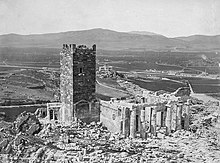
TheAgora(marketplace) had been deserted since late antiquity, began to be built over, and soon the town became an important centre for the production of soaps and dyes. The growth of the town attracted theVenetians,and various other traders who frequented the ports of the Aegean, to Athens. This interest in trade appears to have further increased the economic prosperity of the town.
The 11th and 12th centuries were the Golden Age ofByzantine artin Athens. Almost all of the most important Middle Byzantine churches in and around Athens were built during these two centuries, and this reflects the growth of the town in general. However, this medieval prosperity was not to last. In 1204, theFourth Crusadeconquered Athens and the city was not recovered from theLatinsbefore it was taken by theOttoman Turks.It did not become Greek in government again until the 19th century.
From 1204 until 1458, Athens was ruled by Latins in three separate periods, following theCrusades.The "Latins", or "Franks",were western Europeans and followers of theLatin Churchbrought to theEastern Mediterraneanduring the Crusades. Along with rest of Byzantine Greece, Athens was part of the series of feudalfiefs,similar to theCrusader statesestablished inSyriaand onCyprusafter theFirst Crusade.This period is known as theFrankokratia.
Ottoman Athens
[edit]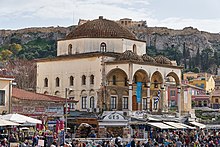

The firstOttomanattack on Athens, which involved a short-lived occupation of the town, came in 1397, under the Ottoman generalsYaqub Pashaand Timurtash.[45]Finally, in 1458, Athens was captured by the Ottomans under the personal leadership of SultanMehmed II.[45]As the Ottoman Sultan rode into the city, he was greatly struck by the beauty of its ancient monuments and issued afirman(imperial edict) forbidding their looting or destruction, on pain of death. TheParthenonwas converted into themain mosqueof the city.[35]
Under Ottoman rule, Athens was denuded of any importance and its population severely declined, leaving it as a "small country town" (Franz Babinger).[45]From the early 17th century, Athens came under the jurisdiction of theKizlar Agha,the chief black eunuch of theSultan's harem.The city had originally been granted by SultanAhmed I(r. 1603–1617) to Basilica, one of his favourite concubines, who hailed from the city, in response of complaints of maladministration by the local governors. After her death, Athens came under the purview of the Kizlar Agha.[46]
The Turks began a practice of storing gunpowder and explosives in the Parthenon andPropylaea.In 1640, a lightning bolt struck the Propylaea, causing its destruction.[47]In 1687, during theMorean War,the Acropoliswas besiegedby the Venetians underFrancesco Morosini,and thetemple of Athena Nikewas dismantled by the Ottomans to fortify the Parthenon. A shot fired during the bombardment of the Acropolis caused a powder magazine in the Parthenon to explode (26 September), and the building was severely damaged, giving it largely the appearance it has today. The Venetian occupation of Athens lasted for six months, and both the Venetians and the Ottomans participated in the looting of the Parthenon. One of its western pediments was removed, causing even more damage to the structure.[35][45]During the Venetian occupation, the two mosques of the city were converted into Catholic and Protestant churches, but on 9 April 1688 the Venetians abandoned Athens again to the Ottomans.[45]
Modern history
[edit]
In 1822, a Greek insurgency captured the city, but it fell to the Ottomans again in 1826 (though Acropolis held till June 1827). Again the ancient monuments suffered badly. The Ottoman forces remained in possession until March 1833, when they withdrew.
Following theGreek War of Independenceand the establishment of theGreek Kingdom,Athens was chosen to replaceNafplioas the second capital of the newly independent Greek state in 1834, largely because of historical and sentimental reasons.[48]At the time, after the extensive destruction it had suffered during the war of independence, it was reduced to a town of about 4,000 people (less than half its earlier population) in a loose swarm of houses along the foot of the Acropolis. The firstKing of Greece,Otto of Bavaria, commissioned the architectsStamatios KleanthisandEduard Schaubertto design a modern city plan fit for the capital of a state.[citation needed]
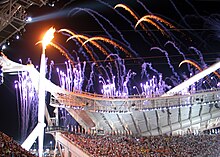
The first modern city plan consisted of a triangle defined by the Acropolis, the ancient cemetery ofKerameikosand the new palace of the Bavarian king (now housing theGreek Parliament), so as to highlight the continuity between modern and ancient Athens. Neoclassicism, the international style of this epoch, was the architectural style through which Bavarian, French and Greek architects such as Hansen, Klenze, Boulanger or Kaftantzoglou designed the first important public buildings of the new capital.[citation needed]In 1896, Athens hosted the first modernOlympic Games.During the 1920s a number ofGreek refugees,expelled fromAsia Minorafter theGreco-Turkish WarandPopulation exchange between Greece and Turkey,swelled Athens's population; nevertheless it was most particularly followingWorld War II,and from the 1950s and 1960s, that the population of the city exploded,[citation needed]and Athens experienced a gradual expansion.
In the 1980s, it became evident that smog from factories and an ever-increasing fleet of automobiles, as well as a lack of adequate free space due to congestion, had evolved into the city's most important challenge.[citation needed]A series of anti-pollution measures taken by the city's authorities in the 1990s, combined with a substantial improvement of the city's infrastructure (including theAttiki Odosmotorway, the expansion of theAthens Metro,and the newAthens International Airport), considerably alleviated pollution and transformed Athens into a much more functional city. In 2004, Athens hosted the2004 Summer Olympics.
Geography
[edit]
Athens sprawls across the central plain of Attica that is often referred to as theAthens Basinor theAttica Basin(Greek:Λεκανοπέδιο Αθηνών/Αττικής,romanized:Lekanopédio Athinón/Attikís). The basin is bounded by four large mountains:Mount Aigaleoto the west, MountParnithato the north,Mount Pentelicusto the northeast and MountHymettusto the east.[49]Beyond Mount Aegaleo lies theThriasian plain,which forms an extension of the central plain to the west. TheSaronic Gulflies to the southwest. Mount Parnitha is the tallest of the four mountains (1,413 m (4,636 ft)),[50]and has been declared anational park.The Athens urban area spreads over 50 kilometres (31 mi) fromAgios Stefanosin the north toVarkizain the south. The city is located in the north temperate zone, 38 degrees north of the equator.
Athens is built around a large number of hills.Lycabettusis one of the tallest hills of the city proper and provides a view of the entire Attica Basin. The meteorology of Athens is deemed to be one of the most complex in the world because its mountains cause atemperature inversionphenomenon which, along with the Greek government's difficulties controlling industrial pollution, was responsible for the air pollution problems the city has faced.[35]This issue is not unique to Athens; for instance, Los Angeles andMexico Cityalso suffer from similar atmospheric inversion problems.[35]
TheCephissusriver, theIlisosand theEridanosstream are the historical rivers of Athens.
Environment
[edit]
By the late 1970s, the pollution of Athens had become so destructive that according to the then GreekMinister of Culture,Constantine Trypanis, "...the carved details on the five the caryatids of theErechtheumhad seriously degenerated, while the face of the horseman on the Parthenon's west side was all but obliterated. "[51]A series of measures taken by the authorities of the city throughout the 1990s resulted in the improvement of air quality; the appearance of smog (ornefosas the Athenians used to call it) has become less common.
Measures taken by the Greek authorities throughout the 1990s have improved the quality of air over the Attica Basin. Nevertheless, air pollution still remains an issue for Athens, particularly during the hottest summer days. In late June 2007,[52]the Attica region experienced a number ofbrush fires,[52]including a blaze that burned a significant portion of a large forested national park inMount Parnitha,[53]considered critical to maintaining a better air quality in Athens all year round.[52]Damage to the park has led to worries over a stalling in the improvement of air quality in the city.[52]
The major waste management efforts undertaken in the last decade (particularly the plant built on the small island of Psytalia) have greatly improvedwater qualityin the Saronic Gulf, and the coastal waters of Athens are now accessible again to swimmers.
Parks and zoos
[edit]
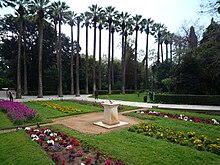
ParnithaNational Park is punctuated by well-marked paths, gorges, springs, torrents and caves dotting the protected area. Hiking and mountain-biking in all four mountains are popular outdoor activities for residents of the city. TheNational Garden of Athenswas completed in 1840 and is a green refuge of 15.5 hectares in the centre of the Greek capital. It is to be found between the Parliament andZappeionbuildings, the latter of which maintains its own garden of seven hectares. Parts of the City Centre have been redeveloped under a masterplan called theUnification of Archeological Sites of Athens,which has also gathered funding from the EU to help enhance the project.[54][55]The landmarkDionysiou Areopagitou Streethas been pedestrianised, forming a scenic route. The route starts from theTemple of Olympian Zeusat Vasilissis Olgas Avenue, continues under the southern slopes of the Acropolis nearPlaka,and finishes just beyond theTemple of HephaestusinThiseio.The route in its entirety provides visitors with views of the Parthenon and theAgora(the meeting point of ancient Athenians), away from the busy City Centre.
The hills of Athens also provide green space.Lycabettus,Philopappos hilland the area around it, includingPnyxandArdettos hill,are planted with pines and other trees, with the character of a small forest rather than typical metropolitan parkland. Also to be found is thePedion tou Areos(Field of Mars) of 27.7 hectares, near theNational Archaeological Museum.Athens' largest zoo is theAttica Zoological Park,a 20-hectare (49-acre) private zoo located in the suburb of Spata. The zoo is home to around 2000 animals representing 400 species, and is open 365 days a year. Smaller zoos exist within public gardens or parks, such as the zoo within the National Garden of Athens.
Climate
[edit]
Athens has a hot-summerMediterranean climate(Köppen climate classification:Csa). Climate in Athens can be considered much hotter (or warmer) than any places with the same distance from the equator (Seoul, Melbourne, Buenos Aires, Cape Town and Norfolk (Virgina, US). According to the meteorological station near the city center which is operated by theNational Observatory of Athens,the downtown area has an annual average temperature of 19.2 °C (66.6 °F) while parts of the urban agglomeration may reach up to 19.8 °C (67.6 °F), being affected by theurban heat islandeffect.[56]Athens receives about 433.1 millimetres (17.05 in) of precipitation per year, largely concentrated during the colder half of the year with the remaining rainfall falling sparsely, mainly during thunderstorms.Fogis rare in the city center, but somewhat more frequent in areas to the east, close to mountHymettus.[57]
The southern section of theAthens metropolitan area(i.e.,Elliniko,Athens Riviera) lies in the transitional zone betweenMediterranean(Csa) and hotsemi-arid climate(BSh), with its port-city ofPiraeusbeing the most extreme example, receiving just 331.9 millimetres (13.07 in) per year. The areas to the south generally see less extreme temperature variations as their climate is moderated by theSaronic gulf.[58]The northern part of the city (i.e.,Kifissia), owing to its higher elevation, features moderately lower temperatures and slightly increased precipitation year-round. The generally dry climate of the Athens basin compared to the precipitation amounts seen in a typicalMediterranean climateis due to therain shadoweffect caused by thePindusmountain range and theDirfysandParnithamountains, substantially drying the westerly[59]and northerly[57]winds respectively.

Snowfall is not very common, though it occurs almost annually, but it usually does not cause heavy disruption to daily life, in contrast to the northern parts of the city, whereblizzardsoccur on a somewhat more regular basis. The most recent examples include the snowstorms of 16 February 2021[60]and 24 January 2022,[61]when the entire urban area was blanketed in snow.
Athens may get particularly hot in the summer, owing partly to the strongurban heat islandeffect characterizing the city.[62]In fact, Athens is considered to be the hottest city inmainland Europe,[63]and is the first city in Europe to appoint a chief heat officer to deal with severeheat waves.[64]Temperatures of 47.5°Chave been reported in several locations of the metropolitan area, including within the urban agglomeration.Metropolitan Athenswas until 2021 the holder of theWorld Meteorological Organizationrecord for the highest temperature ever recorded in Europe with 48.0 °C (118.4 °F) which was recorded in the areas ofElefsinaandTatoion 10 July 1977.[65][66]
| Climate data for downtown Athens (1991–2020), Extremes (1890–present) | |||||||||||||
|---|---|---|---|---|---|---|---|---|---|---|---|---|---|
| Month | Jan | Feb | Mar | Apr | May | Jun | Jul | Aug | Sep | Oct | Nov | Dec | Year |
| Record high °C (°F) | 22.8 (73.0) |
25.3 (77.5) |
28.2 (82.8) |
32.2 (90.0) |
37.6 (99.7) |
44.8 (112.6) |
42.8 (109.0) |
43.9 (111.0) |
38.7 (101.7) |
36.5 (97.7) |
30.5 (86.9) |
23.1 (73.6) |
44.8 (112.6) |
| Mean daily maximum °C (°F) | 13.3 (55.9) |
14.2 (57.6) |
17.0 (62.6) |
21.1 (70.0) |
26.5 (79.7) |
31.6 (88.9) |
34.3 (93.7) |
34.3 (93.7) |
29.6 (85.3) |
24.4 (75.9) |
18.9 (66.0) |
14.4 (57.9) |
23.3 (73.9) |
| Daily mean °C (°F) | 10.2 (50.4) |
10.8 (51.4) |
13.1 (55.6) |
16.7 (62.1) |
21.8 (71.2) |
26.6 (79.9) |
29.3 (84.7) |
29.4 (84.9) |
25.0 (77.0) |
20.3 (68.5) |
15.6 (60.1) |
11.6 (52.9) |
19.2 (66.6) |
| Mean daily minimum °C (°F) | 7.1 (44.8) |
7.3 (45.1) |
9.2 (48.6) |
12.3 (54.1) |
17.0 (62.6) |
21.6 (70.9) |
24.2 (75.6) |
24.4 (75.9) |
20.4 (68.7) |
16.2 (61.2) |
12.2 (54.0) |
8.7 (47.7) |
15.0 (59.0) |
| Record low °C (°F) | −6.5 (20.3) |
−5.7 (21.7) |
−2.6 (27.3) |
1.7 (35.1) |
6.2 (43.2) |
11.8 (53.2) |
16.0 (60.8) |
15.5 (59.9) |
8.9 (48.0) |
5.9 (42.6) |
−1.1 (30.0) |
−4.0 (24.8) |
−6.5 (20.3) |
| Average rainfall mm (inches) | 55.6 (2.19) |
44.4 (1.75) |
45.6 (1.80) |
27.6 (1.09) |
20.7 (0.81) |
11.6 (0.46) |
10.7 (0.42) |
5.4 (0.21) |
25.8 (1.02) |
38.6 (1.52) |
70.8 (2.79) |
76.3 (3.00) |
433.1 (17.06) |
| Averagerelative humidity(%) | 72.0 | 70.0 | 66.0 | 60.0 | 56.0 | 50.0 | 42.0 | 47.0 | 57.0 | 66.0 | 72.0 | 73.0 | 60.9 |
| Averageultraviolet index | 2 | 3 | 5 | 7 | 9 | 10 | 10 | 9 | 6 | 4 | 2 | 2 | 6 |
| Source 1: Cosmos, scientific magazine of theNational Observatory of Athens[67] | |||||||||||||
| Source 2: Meteoclub[68][69] | |||||||||||||
| Climate data forNeos Kosmos85 m a.s.l. | |||||||||||||
|---|---|---|---|---|---|---|---|---|---|---|---|---|---|
| Month | Jan | Feb | Mar | Apr | May | Jun | Jul | Aug | Sep | Oct | Nov | Dec | Year |
| Record high °C (°F) | 22.8 (73.0) |
25.0 (77.0) |
25.4 (77.7) |
31.2 (88.2) |
36.4 (97.5) |
41.2 (106.2) |
42.6 (108.7) |
42.8 (109.0) |
38.1 (100.6) |
32.6 (90.7) |
27.5 (81.5) |
23.4 (74.1) |
42.8 (109.0) |
| Mean daily maximum °C (°F) | 13.9 (57.0) |
15.3 (59.5) |
17.5 (63.5) |
21.7 (71.1) |
25.7 (78.3) |
31.0 (87.8) |
34.0 (93.2) |
33.6 (92.5) |
29.6 (85.3) |
24.0 (75.2) |
19.9 (67.8) |
15.6 (60.1) |
23.5 (74.3) |
| Daily mean °C (°F) | 11.2 (52.2) |
12.4 (54.3) |
14.3 (57.7) |
18.0 (64.4) |
22.1 (71.8) |
27.1 (80.8) |
30.2 (86.4) |
30.0 (86.0) |
26.1 (79.0) |
20.8 (69.4) |
17.0 (62.6) |
13.0 (55.4) |
20.2 (68.3) |
| Mean daily minimum °C (°F) | 8.5 (47.3) |
9.5 (49.1) |
11.0 (51.8) |
14.3 (57.7) |
18.4 (65.1) |
23.2 (73.8) |
26.5 (79.7) |
26.3 (79.3) |
22.5 (72.5) |
17.6 (63.7) |
14.1 (57.4) |
10.3 (50.5) |
16.8 (62.3) |
| Record low °C (°F) | −1.2 (29.8) |
−0.5 (31.1) |
0.0 (32.0) |
5.2 (41.4) |
12.6 (54.7) |
15.8 (60.4) |
19.6 (67.3) |
20.8 (69.4) |
15.7 (60.3) |
9.3 (48.7) |
6.7 (44.1) |
0.9 (33.6) |
−1.2 (29.8) |
| Average rainfall mm (inches) | 53.2 (2.09) |
47.5 (1.87) |
33.6 (1.32) |
19.8 (0.78) |
17.2 (0.68) |
22.0 (0.87) |
6.1 (0.24) |
6.2 (0.24) |
23.3 (0.92) |
43.3 (1.70) |
62.1 (2.44) |
68.5 (2.70) |
402.8 (15.85) |
| Source 1:National Observatory of AthensMonthly Bulletins (Oct 2010 - Jul 2024)[70] | |||||||||||||
| Source 2: Neos Kosmos N.O.A station,[71]World Meteorological Organization[72] | |||||||||||||
| Climate data forElliniko,coastal Athens (1955–2010), Extremes (1957–present) | |||||||||||||
|---|---|---|---|---|---|---|---|---|---|---|---|---|---|
| Month | Jan | Feb | Mar | Apr | May | Jun | Jul | Aug | Sep | Oct | Nov | Dec | Year |
| Record high °C (°F) | 22.4 (72.3) |
24.2 (75.6) |
27.0 (80.6) |
30.9 (87.6) |
35.6 (96.1) |
40.0 (104.0) |
42.2 (108.0) |
43.0 (109.4) |
37.2 (99.0) |
35.2 (95.4) |
28.6 (83.5) |
22.9 (73.2) |
43.0 (109.4) |
| Mean daily maximum °C (°F) | 13.6 (56.5) |
14.1 (57.4) |
15.9 (60.6) |
19.6 (67.3) |
24.4 (75.9) |
29.2 (84.6) |
32.2 (90.0) |
32.2 (90.0) |
28.3 (82.9) |
23.4 (74.1) |
18.8 (65.8) |
15.1 (59.2) |
22.2 (72.0) |
| Daily mean °C (°F) | 10.3 (50.5) |
10.6 (51.1) |
12.4 (54.3) |
16.1 (61.0) |
20.9 (69.6) |
25.6 (78.1) |
28.3 (82.9) |
28.2 (82.8) |
24.3 (75.7) |
19.6 (67.3) |
15.4 (59.7) |
11.9 (53.4) |
18.6 (65.5) |
| Mean daily minimum °C (°F) | 7.0 (44.6) |
7.1 (44.8) |
8.5 (47.3) |
11.5 (52.7) |
15.8 (60.4) |
20.3 (68.5) |
23.0 (73.4) |
23.1 (73.6) |
19.6 (67.3) |
15.7 (60.3) |
12.0 (53.6) |
8.8 (47.8) |
14.4 (57.9) |
| Record low °C (°F) | −2.9 (26.8) |
−4.2 (24.4) |
−2.0 (28.4) |
0.6 (33.1) |
8.0 (46.4) |
11.4 (52.5) |
15.5 (59.9) |
16.0 (60.8) |
10.4 (50.7) |
3.0 (37.4) |
1.4 (34.5) |
−2.0 (28.4) |
−4.2 (24.4) |
| Average rainfall mm (inches) | 47.7 (1.88) |
38.5 (1.52) |
42.3 (1.67) |
25.5 (1.00) |
14.3 (0.56) |
5.4 (0.21) |
6.3 (0.25) |
6.2 (0.24) |
12.3 (0.48) |
45.9 (1.81) |
60.1 (2.37) |
62.0 (2.44) |
366.5 (14.43) |
| Average rainy days | 12.9 | 11.4 | 11.3 | 9.3 | 6.4 | 3.6 | 1.7 | 1.6 | 4.7 | 8.6 | 10.9 | 13.5 | 95.9 |
| Averagerelative humidity(%) | 69.3 | 68.0 | 65.9 | 62.2 | 58.2 | 51.8 | 46.6 | 46.8 | 54.0 | 62.6 | 69.2 | 70.4 | 60.4 |
| Mean monthlysunshine hours | 130.2 | 134.4 | 182.9 | 231.0 | 291.4 | 336.0 | 362.7 | 341.0 | 276.0 | 207.7 | 153.0 | 127.1 | 2,773.4 |
| Source 1:HNMS(1955–2010 normals)[73] | |||||||||||||
| Source 2:Deutscher Wetterdienst(Extremes 1961–1990),[74]Info Climat (Extremes 1991–present)[75][76] | |||||||||||||
Administration
[edit]

Athens became the capital of Greece in 1834, followingNafplion,which was the provisional capital from 1829. The municipality (City) of Athens is also the capital of theAttica region.The termAthenscan refer either to the Municipality of Athens, to Greater Athens or urban area, or to the entire Athens Metropolitan Area.
The largeCity Centre(Greek:Κέντρο της Αθήνας,romanized:Kéntro tis Athínas) of the Greek capital falls directly within theMunicipality of AthensorAthens Municipality(Greek:Δήμος Αθηναίων,romanized:Dímos Athinaíon)—alsoCity of Athens.Athens Municipality is the largest in population size in Greece.Piraeusalso forms a significant city centre on its own[77]within theAthens Urban Areaand it is the second largest in population size within it.
Athens Urban Area
[edit]TheAthens Urban Area(Greek:Πολεοδομικό Συγκρότημα Αθηνών,romanized:Poleodomikó Synkrótima Athinón), also known asUrban Area of the Capital(Greek:Πολεοδομικό Συγκρότημα Πρωτεύουσας,romanized:Poleodomikó Synkrótima Protévousas) orGreater Athens(Greek:Ευρύτερη Αθήνα,romanized:Evrýteri Athína),[78]today consists of 40 municipalities, 35 of which make up what was referred to as the formerAthens Prefecturemunicipalities, located within 4 regional units (North Athens,West Athens,Central Athens,South Athens); and a further 5 municipalities, which make up the formerPiraeus Prefecturemunicipalities, located within theregional unit of Piraeusas mentioned above.
The Athens Municipality forms the core and center of Greater Athens, which in its turn consists of the Athens Municipality and 40 more municipalities, divided in fourregional units(Central, North, South and West Athens), accounting for 2,611,713 people (in 2021)[4]within an area of 361 km2(139 sq mi).[8]Until 2010, which made up the abolished Athens Prefecture and the municipality ofPiraeus,the historic Athenian port, with 4 other municipalities make up the regional unit of Piraeus. The regional units of Central Athens, North Athens, South Athens, West Athens and Piraeus with part of East[79]and West Attica[80]regional units combined make up the continuous Athens Urban Area,[80][81][82]also called the "Urban Area of the Capital" or simply "Athens" (the most common use of the term), spanning over 412 km2(159 sq mi),[83]with a population of 3,059,764 people as of 2021. The Athens Urban Area is considered to form the city of Athens as a whole, despite its administrative divisions, which is the largest in Greece and the 9th most populated urban area in Europe.
|
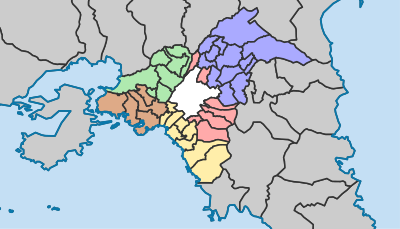
|
Athens metropolitan area
[edit]
The Athens metropolitan area spans 2,928.717 km2(1,131 sq mi) within theAttica regionand includes a total of 58 municipalities, which are organized in seven regional units (those outlined above, along withEast AtticaandWest Attica), having reached a population of 3,638,281 according to the 2021 census.[4]Athens and Piraeus municipalities serve as the two metropolitan centres of the Athens Metropolitan Area.[84]There are also some inter-municipal centres serving specific areas. For example,KifissiaandGlyfadaserve as inter-municipal centres for northern and southern suburbs respectively.


TheAthens Metropolitan Areaconsists of 58[85]densely populated municipalities, sprawling around theMunicipality of Athens(the City Centre) in virtually all directions. For the Athenians, all the urban municipalities surrounding the City Centre are called suburbs. According to their geographic location in relation to theCity of Athens,the suburbs are divided into four zones; the northern suburbs (includingAgios Stefanos,Dionysos,Ekali,Nea Erythraia,Kifissia,Kryoneri,Maroussi,Pefki,Lykovrysi,Metamorfosi,Nea Ionia,Nea Filadelfeia,Irakleio,Vrilissia,Melissia,Penteli,Chalandri,Agia Paraskevi,Gerakas,Pallini,Galatsi,PsychikoandFilothei); the southern suburbs (includingAlimos,Nea Smyrni,Moschato,Tavros,Agios Ioannis Renti,Kallithea,Piraeus,Agios Dimitrios,Palaio Faliro,Elliniko,Glyfada,Lagonisi,Saronida,Argyroupoli,Ilioupoli,Varkiza,Voula,VariandVouliagmeni); the eastern suburbs (includingZografou,Dafni,Vyronas,Kaisariani,CholargosandPapagou); and the western suburbs (includingPeristeri,Ilion,Egaleo,Koridallos,Agia Varvara,Keratsini,Perama,Nikaia,Drapetsona,Chaidari,Petroupoli,Agioi Anargyroi,Ano Liosia,Aspropyrgos,Eleusina,AcharnesandKamatero).
The Athens city coastline, extending from the major commercial port ofPiraeusto the southernmost suburb ofVarkizafor some 25 km (20 mi),[86]is also connected to the City Centre by tram.
In the northern suburb of Maroussi, the upgraded mainOlympic Complex(known by its Greek acronym OAKA) dominates the skyline. The area has been redeveloped according to a design by the Spanish architectSantiago Calatrava,with steel arches, landscaped gardens, fountains, futuristic glass, and a landmark new blue glass roof which was added to the main stadium. A second Olympic complex, next to the sea at the beach of Palaio Faliro, also features modern stadia, shops and an elevated esplanade. Work is underway to transform the grounds of the old Athens Airport – namedElliniko– in the southern suburbs, into one of the largest landscaped parks in Europe, to be named theHellenikon Metropolitan Park.[87]
Many of the southern suburbs (such asAlimos,Palaio Faliro,Elliniko,Glyfada,Voula,VouliagmeniandVarkiza) known as theAthens Riviera,host a number of sandy beaches, most of which are operated by theGreek National Tourism Organisationand require an entrance fee. Casinos operate on both Mount Parnitha, some 25 km (16 mi)[88]from downtown Athens (accessible by car or cable car), and the nearby town ofLoutraki(accessible by car via the Athens –CorinthNational Highway, or theAthens Suburban Railway).
Twin towns – sister cities
[edit]The concept of apartner cityis used under different names in different countries, but they mean the same thing, that two cities in different countries assist each other as partners. Athens has quite a number of partners, whether as a "twin", a "sister", or a "partner."
Demographics
[edit]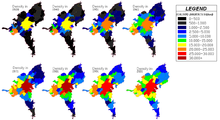
The Municipality of Athens has an official population of 643,452 people (in 2021).[4]According to the2021 Population and Housing Census,The four regional units that make up the former Athens prefecture have a combined population of 2,611,713. They together with theregional unit of Piraeus(sometimes referred as Greater Piraeus) make up the dense Athens Urban Area or Greater Athens which reaches a total population of 3,059,764 inhabitants (in 2021).[4]
The municipality (Center) of Athens is themost populous in Greece,with a population of 643,452 people (in 2021)[4]and an area of 38.96 km2(15.04 sq mi),[7]forming the core of the Athens Urban Area within the Attica Basin. The incumbentMayor of Athensis Charis Doukas of PASOK. The municipality is divided into seven municipal districts which are mainly used for administrative purposes.[89]
For the Athenians the most popular way of dividing the downtown is through its neighbourhoods such asPagkrati,Ampelokipoi,Goudi,Exarcheia,Patisia,Ilisia,Petralona,Plaka,Anafiotika,Koukaki,KolonakiandKypseli,each with its own distinct history and characteristics.
Romani peopleare concentrated in Acharnes, Ano Liosia, Agia Varvara, Zefeiri and Kamatero.[90]
There is a large Albanian community in Athens.[91]
Metropolitan Area
[edit]The Athens Metropolitan Area, with an area of 2,928.717 km2(1,131 sq mi) and inhabited by 3,744,059 people in 2021,[4]consists of the Athens Urban Area with the addition of the towns and villages ofEastandWest Attica,which surround the dense urban area of the Greek capital. It actually sprawls over the whole peninsula of Attica, which is the best part of theregion of Attica,excluding theislands.
| Classification of regional units within Greater Athens, Athens Urban Area and Athens Metropolitan Area | |||||
|---|---|---|---|---|---|
| Regional unit | Population (2021)[4] | Land Area (km2) | Area | ||
| Central Athens | 1,002,212 | 87.4 | Former Athens prefecture 2,611,713 364.2 km2 |
Athens Urban Area or Greater Athens 3,059,764 414.6 km2 |
Athens Metropolitan Area 3,744,059 2931.6 km2 |
| North Athens | 601,163 | 140.7 | |||
| South Athens | 529,455 | 69.4 | |||
| West Athens | 478,883 | 66.7 | |||
| Piraeus | 448,051 | 50.4 | Piraeus regional Unit 448,051 50.4 km2 | ||
| East Attica | 518,755 | 1,513 | |||
| West Attica | 165,540 | 1,004 | |||
Safety
[edit]Athens ranks in the lowest percentage for the risk on frequency and severity of terrorist attacks according to the EU Global Terrorism Database (EIU 2007–2016 calculations). The city also ranked 35th in Digital Security, 21st on Health Security, 29th on Infrastructure Security and 41st on Personal Security globally in a 2017 TheEconomist Intelligence Unitreport.[92]It also ranks as a very safe city (39th globally out of 162 cities overall) on the ranking of the safest and most dangerous countries.[93]As May 2022 the crime index fromNumbeoplaces Athens at 56.33 (moderate), while its safety index is at 43.68.Crime in Athens[94]According to aMercer2019 Quality of Living Survey, Athens ranks 89th on the Mercer Quality of Living Survey ranking.[95]
Economy
[edit]


Athens is thefinancial capitalof Greece. According to data from 2014, Athens as a metropolitan economic area produced US$130 billion as GDP inPPP,which consists of nearly half of the production for the whole country. Athens was ranked 102nd in that year's list of global economic metropolises, while GDP per capita for the same year was 32,000US dollars.[98]
Athens is one of the major economic centres in south-eastern Europe and is considered a regional economic power. The port of Piraeus, where big investments byCOSCOhave already been delivered during the recent decade, the completion of the new Cargo Centre in Thriasion,[99]theexpansion of the Athens Metroand theAthens Tram,as well as theHellenikon metropolitan parkredevelopment in Elliniko and other urban projects, are the economic landmarks of the upcoming years.
Prominent Greek companies such asHellas Sat,Hellenic Aerospace Industry,Mytilineos Holdings,Titan Cement,Hellenic Petroleum,Papadopoulos E.J.,Folli Follie,Jumbo S.A.,OPAP,andCosmotehave their headquarters in the metropolitan area of Athens. Multinational companies such asEricsson,Sony,Siemens,Motorola,Samsung,Microsoft,Teleperformance,Novartis,MondelezandCoca-Colaalso have their regional research and development headquarters in the city. The banking sector is represented byNational Bank of Greece,Alpha Bank,Eurobank,andPiraeus Bank,while theBank of Greeceis also situated in the City Centre. TheAthens Stock Exchangewas severely hit by theGreek government-debt crisisand the decision of the government to proceed intocapital controlsduring summer 2015. As a whole the economy of Athens and Greece was strongly affected, while data showed a change from long recession to growth of 1.4% from 2017 onwards.[100]
Tourism is also a leading contributor to the economy of the city, as one of Europe's top destinations for city-break tourism, and also the gateway for excursions to both the islands and other parts of the mainland. Greece attracted 26.5 million visitors in 2015, 30.1 million visitors in 2017, and over 33 million in 2018, making Greece one of themost visited countries in Europeand the world, and contributing 18% to the country's GDP. Athens welcomed more than 5 million tourists in 2018, and 1.4 million were "city-breakers"; this was an increase by over a million city-breakers since 2013.[101]
Tourism
[edit]Athens has been a destination for travellers since antiquity. Over the 2000s, the city's infrastructure and social amenities have improved, in part because of its successful bid to stage the2004 Olympic Games.The Greek Government, aided by the EU, has funded major infrastructure projects such as the state-of-the-artEleftherios Venizelos International Airport,[102]the expansion of theAthens Metrosystem,[54]and the newAttiki OdosMotorway.[54]In recent years, Athens has become more dynamic with the addition of numerous new bars and cafés and a growing presence ofstreet artandgraffiti,enhancing its urban edge and adding more touristic options alongside the city's archaeological sites and museums.[103]
Transport
[edit]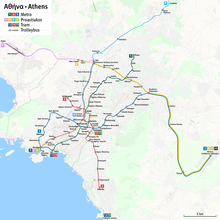
Athens is the country's major transportation hub. The city has Greece's largest airport and its largest port; Piraeus, too, is the largest container transport port in the Mediterranean, and the largest passenger port in Europe.
Athens is a major national hub for Intercity (Ktel) and international buses, as well as for domestic and international rail transport. Public transport is serviced by a variety of transportation means, making up the country's largest mass transit system.Transport for Athensoperates a large bus andtrolleybusfleet, the city'sMetro,aSuburban Railwayservice[104]and atram network,connecting the southern suburbs to the city centre.[105]
Bus transport
[edit]OSY (Greek:ΟΣΥ) (Odikes Sygkoinonies S.A.), a subsidiary company of OASA (Athens urban transport organisation), is the main operator of buses and trolleybuses in Athens. As of 2017, its network consists of around 322 bus lines, spanning the Athens Metropolitan Area, and making up a fleet of 2,375 buses and trolleybuses. Of those 2,375, 619 buses run oncompressed natural gas,making up the largest fleet of natural gas-powered buses in Europe, and 354 are electric-powered (trolleybuses). All of the 354 trolleybuses are equipped to run on diesel in case ofpower failure.[106]
International links are provided by a number of private companies. National and regional bus links are provided byKTELfrom two InterCity Bus Terminals;Kifissos Bus TerminalA andLiosion Bus TerminalB, both located in the north-western part of the city.Kifissosprovides connections towardsPeloponnese,North Greece, West Greece and someIonian Islands,whereasLiosionis used for most of Central Greece. Both of these terminals will be replaced by a new Intercity Bus Terminal under construction inEleonasdue to be completed by 2027.
Railways
[edit]Athens is the hub of thecountry's national railway system(OSE), connecting the capital with major cities across Greece and abroad (Istanbul,Sofia,Belgrade andBucharest).

TheAthens Suburban Railway,referred to as theProastiakos,connects Athens International Airport to the city ofKiato,106 km (66 mi)[107]west of Athens, via Larissa station, the city's central rail station and the port of Piraeus. The length of Athens's commuter rail network extends to 120 km (75 mi),[107]and is expected to stretch to 281 km (175 mi) by 2010.[107]
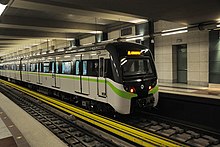
TheAthens Metrois operated by STASY S.A. (Greek:ΣΤΑΣΥ) (Statheres Sygkoinonies S.A.), a subsidiary company of OASA (Athens urban transport organisation), which provides public transport throughout the Athens Urban Area. While its main purpose is transport, it also houses Greek artifacts found during the construction of the system.[108]The Athens Metro runs three metro lines, namelyLine 1 (Green Line),Line 2 (Red Line)andLine 3 (Blue Line)lines, of which the first was constructed in 1869, and the other two largely during the 1990s, with the initial new sections opened in January 2000. Line 1 mostly runs at ground level and the other two (Line 2 & 3) routes run entirely underground. A fleet of 42 trains, using 252 carriages, operates on the network,[109]with a daily occupancy of 1,353,000 passengers.[110]
Line 1(Green Line) serves 24 stations, and is the oldest line of the Athens metro network. It runs fromPiraeusstation toKifissiastation and covers a distance of 25.6 km (15.9 mi). There are transfer connections with the Blue Line 3 atMonastirakistation and with the Red Line 2 atOmoniaandAttikistations.Line 2(Red Line) runs fromAnthoupolistation toEllinikostation and covers a distance of 17.5 km (10.9 mi).[109]The line connects the western suburbs of Athens with the southeast suburbs, passing through the center of Athens. The Red Line has transfer connections with the Green Line 1 atAttikiandOmoniastations. There are also transfer connections with the Blue Line 3 atSyntagmastationand with the tram atSyntagma,Syngrou FixandNeos Kosmosstations.Line 3(Blue Line) runs fromDimotiko Theatrostation, through the centralMonastirakiandSyntagmastations toDoukissis Plakentiasavenue in the northeastern suburb ofHalandri.[109]It then ascends to ground level and continues toAthens International Airport Eleftherios Venizelosusing the suburban railway infrastructure, extending its total length to 39 km (24 mi).[109]The spring 2007 extension from Monastiraki westwards toEgaleoconnected some of the mainnight lifehubs of the city, namely those of Gazi (Kerameikosstation) with Psirri (Monastirakistation) and the city centre (Syntagma station).The new stationsManiatika,PiraeusandDimotiko Theatro,were completed on 10 October 2022,[111][112]connecting the biggest port of Greece, the Port of Piraeus, with Athens International Airport, the biggest airport of Greece.

TheAthens Tramis operated by STASY S.A. (Statheres Sygkoinonies S.A.), a subsidiary company ofTransport for Athens(OASA). It has a fleet of 35Siriotype vehicles[113]and 25Alstom Citadistype vehicles[114]which serve 48 stations,[113]employ 345 people with an average daily occupancy of 65,000 passengers.[113]The tram network spans a total length of 27 km (17 mi) and covers ten Athenian suburbs.[113]The network runs fromSyntagma Squareto the southwestern suburb ofPalaio Faliro,where the line splits in two branches; the first runs along the Athens coastline toward the southern suburb ofVoula,while the other heads toward Piraeus. The network covers the majority of the Athens coastline.[115]
Athens International Airport
[edit]
Athens is served by theAthens International Airport(ATH), located near the town ofSpata,in the eastern Messoghia plain, some 35 km (22 mi) east of center of Athens.[116]The airport, awarded the "European Airport of the Year 2004" Award,[117]is intended as an expandable hub for air travel insoutheastern Europeand was constructed in 51 months, costing 2.2 billion euros. It employs a staff of 14,000.[117]
Ferry
[edit]ThePort of Piraeusis the largest port in Greece and one of the largest in Europe.RafinaandLavrioact as alternative ports of Athens, connects the city with numerousGreek islandsof theAegean Sea,Eviawhile also serving the cruise ships that arrive.
Motorways
[edit]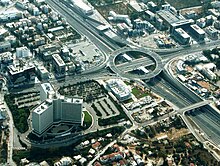
Two main motorways of Greece begin in Athens, namely theA1/E75,heading north towards Greece's second largest city,Thessaloniki;and the border crossing of Evzones and theA8/E94heading west, towards Greece's third largest city,Patras,which incorporated theGR-8A.Before their completion much of the road traffic used theGR-1and theGR-8.
Athens' Metropolitan Area is served by theAttiki Odostoll motorway network: its main section, theA6,extends from the western industrial suburb ofElefsinatoAthens International Airport;while two beltways, namely the Aigaleo Beltway (A65) and the Hymettus Beltway (A62) serve parts of western and eastern Athens respectively. The span of the Attiki Odos in all its length is 65 km (40 mi),[118]making it the largest metropolitan motorway network in all of Greece.
Education
[edit]
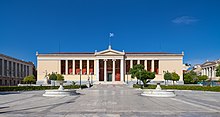

Located onPanepistimiou Street,the old campus of theUniversity of Athens,theNational Library,and theAthens Academyform the "Athens Trilogy" built in the mid-19th century. The largest and oldest university in Athens is the National and Kapodistrian University of Athens. Most of the functions of NKUA along National Technical University of Athens have been transferred to a campus in the eastern suburb ofZografou.TheNational Technical University of Athensold campus is located on Patision Street.
TheUniversity of West Atticais the second largest university in Athens. The seat of the university is located in the western area of Athens, where the philosophers of Ancient Athens delivered lectures. All the activities of UNIWA are carried out in the modern infrastructure of the three University Campuses within the metropolitan region of Athens (Egaleo Park, Ancient Olive Groove and Athens), which offer modern teaching and research spaces, entertainment and support facilities for all students. Other universities that lie within Athens are theAthens University of Economics and Business,thePanteion University,theAgricultural University of Athensand theUniversity of Piraeus.
There are overall ten state-supported Institutions of Higher (or Tertiary) education located in the Athens Urban Area, these are by chronological order:Athens School of Fine Arts(1837),National Technical University of Athens(1837),National and Kapodistrian University of Athens(1837),Agricultural University of Athens(1920),Athens University of Economics and Business(1920),Panteion University of Social and Political Sciences(1927),University of Piraeus(1938),Harokopio University of Athens(1990),School of Pedagogical and Technological Education(2002),University of West Attica(2018). There are also several other privatecolleges,as they called formally in Greece, as the establishment of private universities is prohibited by the constitution. Many of them are accredited by a foreign state or university such as theAmerican College of Greeceand theAthens Campusof theUniversity of Indianapolis.[119]
Culture
[edit]Archaeological hub and museums
[edit]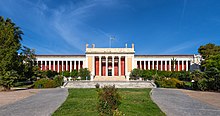


The city is a world centre ofarchaeological research.Alongside national academic institutions, such as theAthens Universityand theArchaeological Society,it is home to multiple archaeological museums, taking in theNational Archaeological Museum,theCycladic Museum,theEpigraphicMuseum, theByzantine & Christian Museum,as well as museums at the ancient Agora,Acropolis,Kerameikos,and theKerameikos Archaeological Museum.The city is also the setting for theDemokritoslaboratory forArchaeometry,alongside regional and national archaeological authorities forming part of theGreek Department of Culture.
Athens hosts 17Foreign Archaeological Instituteswhich promote and facilitate research by scholars from their home countries. As a result, Athens has more than a dozen archaeological libraries and three specialized archaeological laboratories, and is the venue of several hundred specialized lectures, conferences and seminars, as well as dozens of archaeological exhibitions each year. At any given time, hundreds of international scholars and researchers in all disciplines of archaeology are to be found in the city.
Athens' most important museums include:
- theNational Archaeological Museum,the largest archaeological museum in the country, and one of the most important internationally, as it contains a vast collection of antiquities. Its artefacts cover a period of more than 5,000 years, from lateNeolithicAge toRoman Greece;
- theBenaki Museumwith its several branches for each of its collections including ancient, Byzantine, Ottoman-era, Chinese art and beyond;
- theByzantine and Christian Museum,one of the most important museums ofByzantine art;
- theNational Art Gallery,the nation's eponymous leading gallery, which reopened in 2021 after renovation;
- theNational Museum of Contemporary Art,which opened in 2000 in a former brewery building;
- theNumismatic Museum,housing a major collection of ancient and modern coins;
- theMuseum of Cycladic Art,home to an extensive collection ofCycladic art,including its famous figurines of white marble;
- theNew Acropolis Museum,opened in 2009, and replacing the old museum on the Acropolis. The new museum has proved considerably popular; almost one million people visited during the summer period June–October 2009 alone. A number of smaller and privately owned museums focused on Greek culture and arts are also to be found.
- theKerameikos Archaeological Museum,a museum which displays artifacts from the burial site of Kerameikos. Much of the pottery and other artifacts relate to Athenian attitudes towards death and the afterlife, throughout many ages.
- theJewish Museum of Greece,a museum which describes the history and culture ofthe Greek Jewish community.
Architecture
[edit]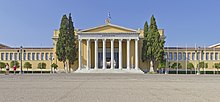
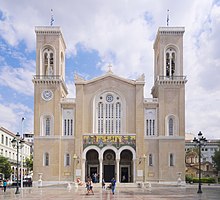
Athens incorporatesarchitectural stylesranging fromGreco-RomanandNeoclassicalto Modern. They are often to be found in the same areas, as Athens is not marked by a uniformity of architectural style. A visitor will quickly notice the absence of tall buildings: Athens has very strictheight restriction lawsin order to ensure the Acropolis Hill is visible throughout the city. Despite the variety in styles, there is evidence of continuity in elements of the architectural environment throughout the city's history.[120]
For the greatest part of the 19th century Neoclassicism dominated Athens, as well as some deviations from it such asEclecticism,especially in the early 20th century. Thus, theOld Royal Palacewas the first important public building to be built, between 1836 and 1843. Later in the mid and late 19th century,Theophil Freiherr von HansenandErnst Zillertook part in the construction of many neoclassical buildings such as theAthens Academyand theZappeionHall. Ziller also designed many private mansions in the centre of Athens which gradually became public, usually through donations, such asSchliemann'sIliou Melathron.
Beginning in the 1920s,modern architectureincludingBauhausandArt Decobegan to exert an influence on almost all Greek architects, and buildings both public and private were constructed in accordance with these styles. Localities with a great number of such buildings includeKolonaki,and some areas of the centre of the city; neighbourhoods developed in this period includeKypseli.[121]
In the 1950s and 1960s during the extension and development of Athens, other modern movements such as theInternational styleplayed an important role. The centre of Athens was largely rebuilt, leading to the demolition of a number of neoclassical buildings. The architects of this era employed materials such as glass, marble and aluminium, and many blended modern and classical elements.[122]After World War II, internationally known architects to have designed and built in the city includedWalter Gropius,with his design for the US Embassy, and, among others,Eero Saarinen,in his postwar design for the east terminal of theEllinikon Airport.
Urban sculpture
[edit]
Across the city numerous statues or busts are to be found. Apart from the neoclassicals byLeonidas Drosisat the Academy of Athens (Plato, Socrates, Apollo and Athena), others in notable categories include the statue ofTheseusbyGeorgios Fytalisat Thiseion; depictions of philhellenes such asLord Byron,George Canning,andWilliam Gladstone;the equestrian statue ofTheodoros KolokotronisbyLazaros Sochosin front of the Old Parliament; statues ofIoannis Kapodistrias,Rigas FeraiosandAdamantios Koraisat the university; ofEvangelos ZappasandKonstantinos Zappasat the Zappeion;Ioannis Varvakisat the National Garden; the "Woodbreaker" byDimitrios Filippotis;the equestrian statue ofAlexandros Papagosin the Papagou district; and various busts of fighters of Greek independence at thePedion tou Areos.A significant landmark is also the Tomb of the Unknown Soldier in Syntagma.
Entertainment and performing arts
[edit]
Athens is home to 148 theatrical stages, more than any other city in the world, including the ancientOdeon of Herodes Atticus,home to theAthens Festival,which runs from May to October each year.[123][124]In addition to a large number of multiplexes, Athens plays host to open air garden cinemas. The city also supports music venues, including theAthens Concert Hall(Megaro Moussikis), which attracts world class artists.[125]The AthensPlanetarium,[126]located inAndrea Syngrou Avenue,inPalaio Faliro[127]is one of the largest and best equipped digital planetaria in the world.[128]TheStavros Niarchos Foundation Cultural Center,inaugurated in 2016, will house theNational Library of Greeceand theGreek National Opera.[129]In 2018 Athens was designated as theWorld Book CapitalbyUNESCO.[130]
Restaurants, tavernas and bars can be found in the entertainment hubs inPlakaand theTrigonoareas of the historic centre, the inner suburbs ofGaziandPsyrriare especially busy with nightclubs and bars, whileKolonaki,Exarchia,Metaxourgeio,KoukakiandPangratioffer more of a cafe and restaurant scene. The coastal suburbs ofMicrolimano,AlimosandGlyfadainclude many tavernas, beach bars and busy summer clubs.

The most successful songs during the period 1870–1930 were the Athenian serenades (Αθηναϊκές καντάδες), based on theHeptaneseankantádhes(καντάδες 'serenades'; sing.: καντάδα) and the songs performed on stage (επιθεωρησιακά τραγούδια 'theatrical revue songs') inrevues,musical comedies,operettasandnocturnesthat were dominating Athens' theatre scene.
In 1922, following the war, genocide and later population exchange suffered by the Greek population of Asia Minor, many ethnic Greeks fled to Athens. They settled in poor neighbourhoods and brought with themRebetikomusic, making it also popular in Greece, and which later became the base for theLaïkomusic. Other forms of song popular today in Greece are elafrolaika, entechno, dimotika, and skyladika.[131]Greece's most notable, and internationally famous, composers of Greek song, mainly of the entechno form, areManos HadjidakisandMikis Theodorakis.Both composers have achieved fame abroad for their composition of film scores.[131]
The renowned American-born Greek sopranoMaria Callasspent her teenage years in Athens, where she settled in 1937.[132][133]Her professional opera career started in 1940 in Athens, with theGreek National Opera.[134]In 2018, the city's municipal Olympia Theatre was renamed to "Olympia City Music Theatre 'Maria Callas'"[135][136]and in 2023, the Municipality inaugurated theMaria Callas Museum,housing it in aneoclassical buildingon 44 Mitropoleos street.[137]
Sports
[edit]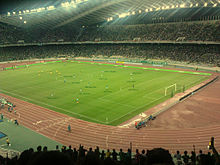

Athens has a long tradition in sports and sporting events, serving as home to the most important clubs inGreek sportand housing a large number of sports facilities. The city has also been host to sports events of international importance.
Athens has hosted theSummer Olympic Gamestwice, in1896and2004.The 2004 Summer Olympics required the development of theAthens Olympic Stadium,which has since gained a reputation as one of the most beautiful stadiums in the world, and one of its most interesting modern monuments.[138]The biggest stadium in the country, it hosted two finals of theUEFA Champions League,in1994and2007.Athens' other major stadiums are theKaraiskakis Stadiumlocated inPiraeus,a sports and entertainment complex, host of the1971 UEFA Cup Winners' Cup Final,andAgia Sophia Stadiumlocated inNea Filadelfeia.
Athens has hosted theEuroLeaguefinal three times, the first in 1985 and second in1993,both at thePeace and Friendship Stadium,most known as SEF, a large indoor arena,[139]and the third time in2007at theOlympic Indoor Hall.Events in other sports such asathletics,volleyball,water poloetc., have been hosted in the capital's venues.
Athens is home to three European multi-sport clubs:Panathinaikos,originated in Athens city centre,Olympiacos,originated in the nearby port city ofPiraeusandAEK Athens,originated in the suburb ofNea Filadelfeia.Infootball,Panathinaikosmade it to the1971 European Cup Final,Olympiacoshave dominated domestic competitions, whileAEK Athensis the other member of thebig three.These clubs also have basketball teams;PanathinaikosandOlympiacosare among the top powers in European basketball, having won theEuroleagueseven times and three respectively, whilstAEK Athenswas the first Greek team to win a European trophy in any team sport.
Other notable clubs within Athens areAthinaikos,Panionios,Atromitos,Apollon,Panellinios,Egaleo F.C.,Ethnikos Piraeus,Maroussi BCandPeristeri B.C.Athenian clubs have also had domestic and international success in other sports.
The Athens area encompasses a variety ofterrain,notably hills and mountains rising around the city, and the capital is the only major city in Europe to be bisected by amountain range.Four mountain ranges extend into city boundaries and thousands of kilometres of trails criss-cross the city and neighbouring areas, providing exercise and wilderness access onfootandbike.
Beyond Athens and across the prefecture of Attica, outdoor activities includeskiing,rock climbing,hang glidingand windsurfing. Numerous outdoor clubs serve these sports, including the Athens Chapter of theSierra Club,which leads over 4,000 outings annually in the area.
Athens was awarded the 2004 Summer Olympics on 5 September 1997 inLausanne,Switzerland, after having lost a previous bid to host the1996 Summer Olympics,toAtlanta,United States.[22]It was to be the second time Athens would host the games, following the inaugural event of 1896. After an unsuccessful bid in 1990, the 1997 bid was radically improved, including an appeal to Greece's Olympic history. In the last round of voting, Athens defeated Rome with 66 votes to 41.[22]Prior to this round, the cities ofBuenos Aires,Stockholm andCape Townhad been eliminated from competition, having received fewer votes.[22]Although the heavy cost was criticized, estimated at $1.5 billion, Athens was transformed into a more functional city that enjoys modern technology both in transportation and in modernurban development.[140]The games welcomed over 10,000 athletes from all 202 countries.[140]
See also
[edit]Notes
[edit]- ^Greek:Αθήνα,romanized:Athína,pronounced[aˈθina];Ancient Greek:Ἀθῆναι,romanized:Athênai,pronounced[atʰɛ̂ːnai̯]
References
[edit]- ^"Athens: City of Wisdom".Washington Independent Review of Books. 30 March 2022.Retrieved10 September2022.
- ^"Athens and Jerusalem: City of Reason, City of Faith".RANE Network. 15 July 2022.Retrieved18 October2022.
- ^Municipality of Athens, Municipal elections – October 2023,Ministry of Interior
- ^abcdefghij"Census 2021 GR"(PDF)(Press release).Hellenic Statistical Authority.19 July 2022.Archived(PDF)from the original on 9 October 2022.Retrieved12 September2022.
- ^"Gross domestic product (GDP) at current market prices by metropolitan regions".
- ^Wells, John C. (1990). "Athens".Longman pronunciation dictionary.Harlow, England: Longman. p. 48.ISBN0-582-05383-8.
- ^ab"Population & housing census 2001 (incl. area and average elevation)"(PDF)(in Greek). National Statistical Service of Greece. Archived fromthe original(PDF)on 21 September 2015.
- ^abc"Characteristics".Hellenic Interior Ministry.ypes.gr. Archived fromthe originalon 4 January 2007.Retrieved6 January2007.
- ^Vinie Daily, Athens, the city in your pocket, p. 6.
- ^Greenberg, Mike; PhD (23 February 2021)."Athena Facts: Things that not many people know about..."Retrieved20 February2024.
- ^"Contents and Principles of the Programme of Unification of the Archaeological Sites of Athens".Hellenic Ministry of Culture.yppo.gr.Archivedfrom the original on 21 August 2016.Retrieved31 December2009.
- ^CNN & Associated Press (16 January 1997)."Greece uncovers 'holy grail' of Greek archeology".CNN. Archived fromthe originalon 6 December 2007.Retrieved28 March2007.
- ^Encarta Ancient Greecefrom the Internet Archive– Retrieved on 28 February 2012.Archived31 October 2009.
- ^ab"Athens".Archivedfrom the original on 6 January 2009.Retrieved31 December2008.
Ancient Greek Athenai, historic city and capital of Greece. Many of classical civilization's intellectual and artistic ideas originated there, and the city is generally considered to be the birthplace of Western civilization
- ^abBBC History on Greek DemocracyArchived19 December 2019 at theWayback Machine– Accessed on 26 January 2007
- ^"The World According to GaWC 2020".GaWC – Research Network.Globalization and World Cities.Archivedfrom the original on 24 August 2020.Retrieved31 August2020.
- ^"Maritime passenger statistics".Eurostat.Eurostat.21 November 2022.Retrieved25 March2023.
- ^"World Shipping Council- Top 50 Ports".World Shipping Council.Retrieved7 July2022.
- ^Monthly Statistical Bulletin of Greece, December 2012.ELSTAT. 2012. p. 64.
- ^"Μόνιμος Πληθυσμός – ELSTAT".www.statistics.gr.Archived fromthe originalon 5 January 2023.Retrieved10 June2023.
- ^"Athens, Greece Metro Area Population 1950–2023".www.macrotrends.net.Retrieved2 March2023.
- ^abcdCNN & Sports Illustrated (5 September 1997)."Sentiment a factor as Athens gets 2004 Olympics".sportsillustrated.cnn.com. Archived fromthe originalon 19 May 2008.Retrieved28 March2007.
- ^As for example inOd.7.80Archived18 April 2021 at theWayback Machine
- ^abBeekes, Robert S. P.(2009),Etymological Dictionary of Greek,Leiden and Boston: Brill, p. 29
- ^abcBurkert, Walter(1985),Greek Religion,Cambridge, Massachusetts: Harvard University Press, p.139,ISBN0-674-36281-0
- ^abcdefghKerényi, Karl(1951),The Gods of the Greeks,London, England: Thames and Hudson, p.124,ISBN0-500-27048-1
- ^abGarland, Robert (2008).Ancient Greece: Everyday Life in the Birthplace of Western Civilization.New York: Sterling.ISBN978-1-4549-0908-8.
- ^Great Greek Encyclopedia,vol. II, Athens 1927, p. 30.
- ^"ToposText".topostext.org.Archivedfrom the original on 25 February 2021.Retrieved27 March2020.
- ^Bourne, Edward G. (1887). "The Derivation of Stamboul".American Journal of Philology.8(1). The Johns Hopkins University Press: 78–82.doi:10.2307/287478.ISSN0002-9475.JSTOR287478.
- ^'General Storia' (Global History)
- ^Osmanlı Yer Adları,Ankara 2017,s.v.full textArchived31 July 2020 at theWayback Machine
- ^"v4.ethnos.gr – Οι πρώτοι… Αθηναίοι".Ethnos.gr. July 2011. Archived fromthe originalon 21 July 2011.Retrieved26 October2018.
- ^S. Immerwahr, The Athenian Agora XIII: the Neolithic and Bronze Ages, Princeton 1971
- ^abcdefTung, Anthony (2001)."The City the Gods Besieged".Preserving the World's Great Cities: The Destruction and Renewal of the Historic Metropolis.New York: Three Rivers Press. p.266.ISBN0-609-80815-X.
- ^Iakovides, S. 1962. 'E mykenaïke akropolis ton Athenon'. Athens.
- ^Desborough, Vincent R. d'A(1964).The Last Mycenaeans and Their Successors; an Archaeological Survey, c. 1200–c. 1000 B.C.Oxford: Clarendon Press. p. 113.
- ^Little, Lisa M. (1988)."A Social Outcast in Early Iron Age Athens".Hesperia: The Journal of the American School of Classical Studies at Athens.67, No. 4 (Oct. – Dec. 1998): 375–404.JSTOR148450– via JSTOR.
- ^Osborne, R. 1996, 2009.Greece in the Making 1200–479 BC.
- ^Lewis, John David (25 January 2010).Nothing Less than Victory: Decisive Wars and the Lessons of History.Princeton University Press.ISBN978-1400834303.Archivedfrom the original on 12 March 2020.Retrieved24 December2014.
- ^Xenophon,Hellenica,2.2.20, 404/3
- ^Kouremenos, Anna (2022). "'The City of Hadrian and not of Theseus': A Cultural History of Hadrian's Arch". In A. Kouremenos (ed.)The Province of Achaea in the 2nd century CE: The Past Present.London: Routledge.https://www.academia.edu/43746490/_2022_The_City_of_Hadrian_and_not_of_Theseus_a_cultural_history_of_Hadrians_Arch
- ^abcdefgGregory, Timothy E.; Ševčenko, Nancy Patterson (1991). "Athens". InKazhdan, Alexander(ed.).The Oxford Dictionary of Byzantium.Oxford and New York: Oxford University Press. pp. 221–223.ISBN978-0-19-504652-6.
- ^Alan Cameron, "The Last Days of the Academy at Athens," in A. Cameron, Wandering Poets and Other Essays on Late Greek Literature and Philosophy, 2016, (Oxford University Press: Oxford), pp. 205–246
- ^abcdefBabinger, Franz(1986). "Atīna".The Encyclopedia of Islam, New Edition, Volume I: A–B.Leiden and New York: BRILL. pp. 738–739.ISBN90-04-08114-3.
- ^Augustinos, Olga (2007)."Eastern Concubines, Western Mistresses: Prévost'sHistoire d'une Grecque moderne".In Buturović, Amila; Schick, İrvin Cemil (eds.).Women in the Ottoman Balkans: Gender, Culture and History.London and New York: I.B. Tauris. p. 24.ISBN978-1-84511-505-0.
- ^"and (Dontas, The Acropolis and its Museum, 16)".Ancient-greece.org. 21 April 2007.Retrieved22 March2009.
- ^Wynn, Martin (1984).Planning and Urban Growth in Southern Europe.Mansell. p. 6.ISBN978-0720116083.
- ^"Focus on Athens"(PDF).UHI Quarterly Newsletter, Issue 1, May 2009, page 2.urbanheatisland.info. Archived fromthe original(PDF)on 22 July 2013.Retrieved18 March2011.
- ^"Welcome!!!".Parnitha-np.gr.Archivedfrom the original on 28 January 2019.Retrieved10 June2009.
- ^"Acropolis: Threat of Destruction".Time.31 January 1977. Archived fromthe originalon 30 September 2007.Retrieved3 April2007.
- ^abcdKitsantonis, Niki (16 July 2007)."As forest fires burn, suffocated Athens is outraged".International Herald Tribune.Archived fromthe originalon 18 September 2007.Retrieved3 February2008.
- ^Συνέντευξη Τύπου Γ. Σουφλιά για την Πάρνηθα(Press release) (in Greek). Hellenic Ministry for the Environment, Physical Planning, & Public Works. 18 July 2007. Archived fromthe original(.doc)on 16 February 2008.Retrieved15 January2008.
Συνολική καμένη έκταση πυρήνα Εθνικού Δρυμού Πάρνηθας: 15.723 (Σύνολο 38.000)
- ^abc"Olympic Games 2004: five major projects for Athens".European Union Regional Policy.ec.europa.eu. Archived fromthe originalon 20 May 2007.Retrieved5 April2007.
- ^"Eaxa:: Ενοποιηση Αρχαιολογικων Χωρων Αθηνασ Α.Ε".Astynet.gr.Archivedfrom the original on 28 February 2009.Retrieved21 March2009.
- ^"Climate Atlas of Greece".Hellenic National Meteorological Service.Archivedfrom the original on 4 February 2022.Retrieved10 April2022.
- ^ab"Practical Information About Athens".www.ippcathens2024.gr.Retrieved31 May2023.
- ^Melas, D.; Ziomas, I.; Klemm, O.; Zerefos, C. S. (1 June 1998)."Anatomy of the sea-breeze circulation in Athens area under weak large-scale ambient winds".Atmospheric Environment.32(12): 2223–2237.Bibcode:1998AtmEn..32.2223M.doi:10.1016/S1352-2310(97)00420-2.ISSN1352-2310.
- ^"Mountain Weather in Greece: Articles: SummitPost".www.summitpost.org.Retrieved31 May2023.
- ^"Unusually heavy snow blankets Athens – in pictures".The Guardian.16 February 2021.Archivedfrom the original on 21 December 2021.Retrieved21 December2021.
- ^"Severe weather brings snow to Athens, Greek islands".Ekhatimerini. 24 January 2022.Archivedfrom the original on 24 January 2022.Retrieved24 January2022.
- ^Giannaros, Theodore M.; Melas, Dimitrios; Daglis, Ioannis A.; Keramitsoglou, Iphigenia; Kourtidis, Konstantinos (1 July 2013)."Numerical study of the urban heat island over Athens (Greece) with the WRF model".Atmospheric Environment.73:103–111.Bibcode:2013AtmEn..73..103G.doi:10.1016/j.atmosenv.2013.02.055.ISSN1352-2310.
- ^"Athens will be the first European city to appoint a chief heat officer".Fast Company media magazine.Retrieved10 April2022.
- ^"Athens' chief heat officer prepares the city for the climate crisis".euronews.24 June 2022.Retrieved8 June2023.
- ^"World Meteorological Organization's World Weather & Climate Extremes Archive".Arizona State Universitywebsite.World Meteorological Organization.Archivedfrom the original on 24 September 2016.Retrieved23 September2016.
- ^"WMO is monitoring potential new temperature records".public.wmo.int.17 July 2023.Retrieved17 July2023.
- ^"Το 'νέο' κλίμα της Αθήνας – Περίοδος 1991–2020".National Observatory of Athens.Archivedfrom the original on 21 October 2021.Retrieved3 July2021.
- ^"Το κλίμα της Αθήνας".www.meteoclub.gr.Archivedfrom the original on 21 October 2021.Retrieved3 July2021.
- ^"Το αρχείο του Θησείου".www.meteoclub.gr.Archivedfrom the original on 4 May 2016.Retrieved1 May2016.
- ^"Meteo.gr - Προγνώσεις καιρού για όλη την Ελλάδα".
- ^"Latest Conditions in Neos Kosmos, Athens".
- ^"World Meteorological Organization".Retrieved14 July2023.
- ^"Climatic Data for selected stations in Greece: Elliniko (Elliniko)".Archivedfrom the original on 5 February 2021.Retrieved5 February2021.
- ^"Klimatafel von Athen Flughafen (Hellinikon) / Griechenland"(PDF).Baseline climate means (1961–1990) from stations all over the world.Deutscher Wetterdienst.Archived(PDF)from the original on 12 June 2020.Retrieved15 May2020.
- ^"Climatic Data for selected stations in Greece: Athens Airport".Archivedfrom the original on 5 February 2021.Retrieved15 May2020.
- ^Kapikian, Etienne [@EKMeteo] (9 January 2021)."Aussi 22.4°C #Athènes-Ellinikon record mensuel à la station"(Tweet) (in French).Archivedfrom the original on 9 January 2021.Retrieved10 January2021– viaTwitter.
- ^"Distance between Athens, Greece and Piraeus, Greece".distances-from.com. 9 December 2007. Archived fromthe originalon 9 February 2018.Retrieved8 February2018.
- ^"Greater Athens (Greece): Municipalities – Population Statistics, Charts and Map".citypopulation.de.Archivedfrom the original on 3 May 2020.Retrieved24 May2020.
- ^"Concise Statistical Yearbook of Greece 2001 page 38, National Statistical Service of Greece"(PDF).Archived(PDF)from the original on 1 July 2019.Retrieved26 August2019.
- ^ab"Αttikh".EraNET(in Greek).Archivedfrom the original on 29 June 2019.Retrieved8 August2019.
- ^"Monthly Statistical Bulletin Monthly Statistical Bulletin December 2012, Hellenic Statistical Authority, page 64"(PDF).Archived(PDF)from the original on 13 July 2020.Retrieved29 August2019.
- ^"Statistical Yearbook of Greece 2001 page 72, National Statistical Service of Greece"(PDF).Archived(PDF)from the original on 1 July 2019.Retrieved8 August2019.
- ^"ΦΕΚ B 1292/2010, Kallikratis reform municipalities"(in Greek).Government Gazette.Archivedfrom the original on 10 October 2021.Retrieved9 September2021.
- ^"Master Plan for Athens and Attica 2021, pg 13, 24, 27, 33, 36, 89".Archived fromthe originalon 21 March 2012.
- ^"ΕΛΣΤΑΤ Απογραφη 2011"(PDF).statistics.gr. Archived fromthe original(PDF)on 11 October 2011.Retrieved22 August2011.
- ^"Distance between Piraeus (Attiki) and Varkiza (Piraios Nomos) (Greece)".Distancecalculator.globefeed.com. 9 December 2007.Archivedfrom the original on 11 July 2011.Retrieved9 June2009.
- ^"Hellenikon Metropolitan Park Competition".Hellenic Ministry of the Environment and Public Works.minenv.gr. Archived fromthe originalon 8 April 2004.Retrieved3 January2007.
- ^"Europe | Greek forest fire close to Athens".BBC News.29 June 2007.Archivedfrom the original on 27 August 2009.Retrieved9 June2009.
- ^"PAGE-themes".statistics.gr. Archived fromthe originalon 6 October 2014.Retrieved3 October2014.
- ^"International Roma Day: The Stigmatized People of Greece".
- ^King, Russell; Iosifides, Theodoros; Myrivili, Lenio (1998)."A migrant's story: From Albania to Athens".Journal of Ethnic and Migration Studies.24:159–175.doi:10.1080/1369183X.1998.9976623.
- ^"Safe Cities Index 2017: Security in a rapidly urbanizing world"(PDF).The Economist Intelligent Unit. 9 December 2017.Archived(PDF)from the original on 16 October 2017.Retrieved8 February2018.
- ^"Athens Safety Index".Safe Around.Archivedfrom the original on 29 October 2019.Retrieved1 September2019.
- ^"Is Athens Safe? Areas to Avoid and Other Warnings".Mercer. 26 February 2019.Archivedfrom the original on 16 July 2019.Retrieved8 February2019.
- ^"Athens Has the Biggest Fall in Mercer's 21st Personal Safety Ranking".Mercer. 13 March 2019.Archivedfrom the original on 19 March 2019.Retrieved8 February2018.
- ^"Economy and Banking Sector of Greece".The European Banks.
- ^"List of Banks in Greece – Overview of Top 10 Greek Banks".ADV Ratings.Retrieved10 March2023.
- ^Parilla, Joseph; Berube, Alan; Leal Trujillo, Jesus; Ran, Tao (22 January 2015)."Global Metro Monitor".Brookings.Archivedfrom the original on 7 January 2019.Retrieved23 February2019.
- ^"Cargo container centers".GAIA OSE.8 October 2017.Archivedfrom the original on 24 February 2019.Retrieved24 February2019.
- ^"Report for Selected Countries and Subjects".International Monetary Fund.Archived fromthe originalon 24 February 2019.Retrieved24 February2019.
- ^"Εξαπλασιάστηκαν σε μία πενταετία οι τουρίστες στην πρωτεύουσα, Του Ηλία Μπέλλου".Kathimerini.8 March 2018.Archivedfrom the original on 24 February 2019.Retrieved24 February2019.
- ^"Financial Statements as at 31 December 2007"(PDF).Athens International Airport, S.A.Archived fromthe original(PDF)on 5 February 2009.Retrieved5 April2007.
- ^"How angry street art is making Athens hip".The Economist.ISSN0013-0613.Retrieved22 July2024.
- ^"Suburban Railway".TrainOSE.Archived from the original on 18 April 2021.Retrieved28 March2021.
{{cite web}}:CS1 maint: unfit URL (link) - ^"The tram of Athens".Tram Sa. Archived fromthe originalon 14 January 2009.Retrieved5 January2009.
- ^"Στόλος λεωφορείων".Ο.ΣΥ. Α.Ε.(in Greek). Archived fromthe originalon 17 April 2021.Retrieved28 March2021.
- ^abc"Proastiakos".proastiakos.gr. Archived fromthe originalon 3 February 2009.Retrieved9 June2009.
- ^"Athens Metro".Hellenic Ministry of Culture.culture.gr. Archived fromthe originalon 7 December 2006.Retrieved26 January2007.
- ^abcd"Athens Urban Transport Network in Facts and Figures (pdf) page 15"(PDF).OASA.oasa.gr. Archived fromthe original(PDF)on 29 June 2006.Retrieved4 February2007.
- ^"Homepage – The Company – Attiko Metro S.A." Attiko Metro S.A. Archived from the original on 3 December 2010. Retrieved 2 June 2014.
- ^"Line3".Attiko Metro.ametro.gr.
- ^"Athens Greece Guide".Athensguide.org.
- ^abcd"Tram Sa".Tramsa.gr. Archived fromthe originalon 21 July 2011.Retrieved25 October2009.
- ^"Alstom introduces the Citadis X05 tram to Athens".Alstom.Retrieved19 April2023.
- ^"Athens Urban Transport Network in Facts and Figures (pdf) page 13"(PDF).OASA.oasa.gr. Archived fromthe original(PDF)on 29 June 2006.Retrieved28 January2007.
- ^"Athens International Airport: Facts and Figures".Athens International Airport.aia.gr.Archivedfrom the original on 6 April 2008.Retrieved11 February2007.
- ^ab"Athens International Airport: Airport Profile".Athens International Airport.aia.gr.Archivedfrom the original on 7 June 2007.Retrieved11 February2007.
- ^"Aodos.gr".[permanent dead link]
- ^"Ιδιωτικά Πανεπιστήμια στην Ελλάδα – Private Universities in Greece".www.thought.de.Archivedfrom the original on 25 June 2012.Retrieved12 June2012.
- ^Doumas, Christos (April 1998)."1998 Excavation and rescue operations: what to preserve and why".Museum International.50(2). UNESCO: 6–9.doi:10.1111/1468-0033.00142.Retrieved4 July2022.
- ^Fessas-Emmanouil, Helen.Ελληνική Αρχιτεκτονική Εταιρεία: Αρχιτέκτονες του 20ού αιώνα: Μέλη της Εταιρείας,Ποταμός, Athens, 2009, p. XXV and p. XXI,ISBN960-6691-38-1
- ^Fessas-Emmanouil, Helen.Ελληνική Αρχιτεκτονική Εταιρεία: Αρχιτέκτονες του 20ού αιώνα: Μέλη της Εταιρείας,Ποταμός, Athens, 2009, p. XXXI,ISBN960-6691-38-1
- ^"Home Page".Urban Audit. Archived fromthe originalon 6 February 2009.Retrieved21 March2009.
- ^"Athens – Epidaurus Festival 2008".Greekfestival.gr.Archivedfrom the original on 22 February 2009.Retrieved21 March2009.
- ^"Megaron Events Chart".Megaron.gr. 26 October 1997. Archived fromthe originalon 1 February 2009.Retrieved21 March2009.
- ^Ίδρυμα Ευγενίδου. Εκπαιδευτικό Κοινωφελές Ίδρυμα(in Greek). Eugenfound.edu.gr.Archivedfrom the original on 8 June 2008.Retrieved21 March2009.
- ^Rizzo, Demetrio."Athens Today".athens-today.com.Archivedfrom the original on 28 November 2020.Retrieved29 May2020.
- ^"Athens Eugenides Planetarium".Barco. Archived fromthe originalon 7 July 2011.Retrieved16 June2011.
- ^"Vision".SNFCC.Archivedfrom the original on 16 November 2016.Retrieved16 November2016.
- ^"Athens: Books everywhere".UNESCO.29 March 2018.Archivedfrom the original on 23 April 2022.Retrieved31 March2022.
- ^abAthens – The Truth: Searching for Mános, Just Before the Bubble Burst.Tales of Orpheus. 1 September 2013.ISBN9780955209031.Archivedfrom the original on 5 February 2021.Retrieved24 October2013.
- ^Rémy, Pierre-Jean (1978).Maria Callas, a tribute.Internet Archive. New York: St. Martin's Press. p. 19.ISBN978-0-312-51448-8.
- ^Petsalis-Diomidis, Nikolaos (2001).The unknown Callas: the Greek years.Internet Archive. Portland, Or.:Amadeus Press.pp. 76, 88.ISBN978-1-57467-059-2.
- ^Petsalis-Diomidis, Nikolaos (2001).The unknown Callas: the Greek years.Opera biography series. Portland, Or:Amadeus Press.p. 214.ISBN978-1-57467-059-2.
- ^"Olympia | ΟΛΥΜΠΙΑ ΔΗΜΟΥ ΑΘΗΝΑΙΩΝ".24 February 2023.Retrieved31 October2023.
- ^Βατόπουλος, Νίκος (30 November 2018).""Ολύμπια", η μεγάλη επιστροφή ".Η ΚΑΘΗΜΕΡΙΝΗ(in Greek).Retrieved31 October2023.
- ^IEFIMERIDA.GR, NEWSROOM (25 October 2023)."Maria Callas museum, first in the world, opens in central Athens".iefimerida.gr(in Greek).Retrieved29 October2023.
- ^"Athens 21st Century – Athens Olympic Stadium".Athens-today.com.Archivedfrom the original on 16 February 2009.Retrieved26 December2008.
- ^"Athens 21st Century – The Olympic Coastal Complex".Athens-today.com.Archivedfrom the original on 14 February 2009.Retrieved26 December2008.
- ^ab"Athens bids farewell to the Games".CNN.30 August 2004.Archivedfrom the original on 15 January 2008.Retrieved29 March2007.
External links
[edit]- Official websiteof the Municipality of Athens
- Athens
- Ancient Greek archaeological sites in Greece
- Archaeological sites in Attica
- Capitals in Europe
- Capitals of Greek states
- City-states
- Greek regional capitals
- Populated coastal places in Greece
- Populated places established in the 5th century BC
- Populated places in ancient Greece
- Populated places in Central Athens (regional unit)
- Roman sites in Greece
- Athens Riviera











